In case you hadn’t noticed there is a four-weekly cycle of blog posts here at the Renaissance Mathematicus. Week one is a new series post, week two a fairly random #histSTM post, week three the next new series post, and week four a book review. Sometimes I throw in a random HISTSCI_HULK post just because. Today should be the next series post but I posted the last episode of my Renaissance Science series two weeks ago. You might be pleased or dismayed to learn that I have a new series lined up, at least in my head, but I want to take a little breathing space before I start in on it. To bridge the gap, I shall be posting a series of posts, which are sort of related to the Renaissance Science series, on a book by Paul Strathern, The Other Renaissance: From Copernicus to Shakespeare, (Atlantic Books, 2023). The Other Renaissance is, of course, what is normally referred to as the Northern Renaissance.
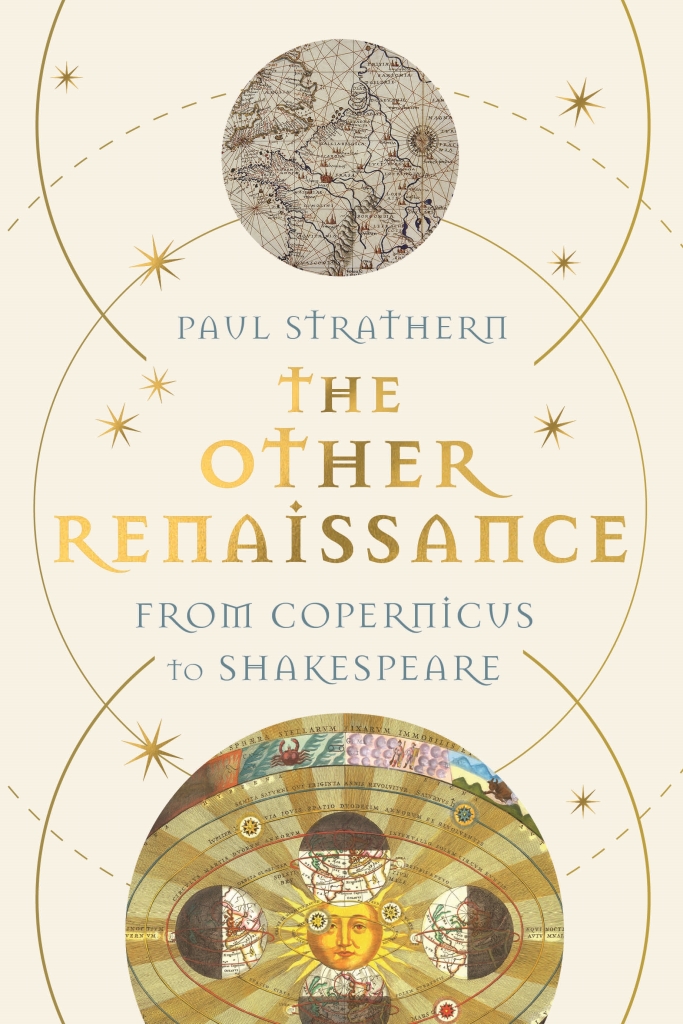
I must admit that I had never heard of Paul Strathern, but a friend, who shall remain nameless, received a review copy of this book, and thought it was so bad that he decided not to review it at all. My historical garbage antenna went up and I made further inquiries, whereupon said friend was kind enough to send me a pdf of said book. And yes folks, it is truly a stinker. I don’t intend to review the whole thing, but I thought I would post a series of HISTSCI_HULK typical put downs of selected elements of the text.
However, before we get down to the nitty-gritty a few words about our author. According to his Wikipedia page, Paul Strathern (born 1940!!) is a Scots Irish writer and academic, and an incredibly prolific writer he is too. To date, he has published five novels, fifteen “academic” books, nineteen titles in his Philosophers in 90 Minutesseries, eleven titles in his Great Writers in 90 Minutes series, twelve titles in his The Big Idea: Scientists Who Changed the World series, and finally three travel guides. I wonder what he does in his spare time? Also, if his The Big Idea: Scientists Who Changed the World are as bad as his The Other Renaissance: From Copernicus to Shakespeare, then I’m glad that the HISTSCI_HULK hasn’t read any of them.
As I will be only commenting on selected bits of the book here is the full contents list:
Map viii–ix Timeline of Significant Events during the Northern Renaissance x-xi
Prologue: Lifting the Lid 1
1 Gutenberg 13
2 Jan van Eyck 21
3 Nicholas of Cusa 33
4 Francis I and the French Renaissance 47
5 A New Literature: Rabelais 63
6 Martin Luther and the Protestant Reformation 73
7 The Rise of England 89
8 The Rise and Rise of the Fuggers 105
9 Copernicus 125
10 Erasmus 141
11 Dürer 157
12 Straddling Two Ages: Paracelsus and Bruegel the Elder 175
13 Versions of the True: Mercator and Viète 193
14 Vesalius 211
15 Catherine de’ Medici 229
16 Montaigne 249
17 Elizabethan England 265
18 Brahe and Kepler 281
19 Europe Expands 301
Conclusion: A Last Legacy 317
And the timeline: (The formatting is a bit weird, result of my cut and paste)
TIMELINE OF SIGNIFICANT EVENTS DURING THE NORTHERN RENAISSANCE
1415 Jan Hus, founder of the Hussites, burned at the stake
1432 Van Eyck completes the Ghent Altarpiece
1460s Regiomontanus oversees the building of the first observatory in Europe (Rubbish!)
1464 Death of Nicholas of Cusa
1474 Technique of painting in oils spreads from the Netherlands to Italy
1494 Signing of the Treaty of Tordesillas: Pope Alexander VI draws a line down the Atlantic Ocean, dividing the globe between Spain and Portugal
1497 John Cabot sails from Bristol and reaches North America1509 Erasmus writes In Praise of Folly
1512 Torrigiano is commissioned by Henry VIII to create a Renaissance tomb for Henry VII1514 Dürer produces Melencolia I
1515 Francis I ascends to the throne of France
1517 Martin Luther nails his Ninety-Five Theses to the door of Wittenberg Castle Church
1519 The death of Leonardo da Vinci in France
1519 Charles V is crowned Holy Roman Emperor
1525 Death of Jacob Fugger the Rich
1529 The Colloquy of Marburg fails to unite Protestants1533 Henry VIII breaks with Rome
1536 John Calvin arrives in Geneva; Calvinist missionaries soon begin to spread over northern Europe
1536 French explorer Jacques Cartier brings Chief Donnacona from the New World to see Francis I
1541 Death of Paracelsus
1543 Copernicus is shown the first published edition of his De Revolutionibus Orbium Coelestium, describing the solar system, while on his deathbed
1543 Vesalius publishes De Fabrica, describing human anatomy
1547 The completion of the Château de Chambord in the Loire Valley1547 The death of Francis I of France
1553 The death of Rabelais
1553 English explorer Richard Chancellor visits the court of Ivan the Terrible
1558 The death of Holy Roman Emperor Charles V
1569 Mercator publishes his Atlas, containing his cylindrical projection map of the world
1572 The St Bartholomew’s Day massacre of Huguenots in France1588 The Spanish Armada fails to invade Elizabethan England
1589 The death of Catherine de’ Medici, mother of French kings and ruler of France
1596 Johannes Kepler publishes his laws describing the elliptical orbit of plants (Like this typo!)
1600 The founding of the East India Company in London
1601 Tycho Brahe dies in Prague
1608 Invention of the perspicillium in Holland, which inspires Galileo to create the telescope (Rubbish!)
1616 The death of Shakespeare
1642 Cardinal Richelieu dies in France
1648 The Peace of Westphalia ends the Thirty Years’ WarI decided to start this week with Strathern’s chapter on Albrecht Dürer, as I have a local connection to the man.
After a conventional biographical introduction from birth to marriage, Strathern tells us:
Dürer did not travel on his own. He is thought to have been accompanied by an ebullient rugged-faced companion named Willibald Pirckheimer, [my emphasis] whose appearance belied his acute intelligence and thirst for learning. Pirckheimer came from a distinguished family in Nuremberg, was a year older than Dürer, and was filled with patrician self-confidence. He was studying law at Padua, and during the course of their friendship Pirckheimer would fill the huge gaps in Dürer’s education, introducing him to the humanist ideas he had picked up at university and amongst his father’s intellectual circle in Nuremberg.
When I read that Dürer, on his first journey to Italy, was accompanied by Willibald Pirckheimer, I did a double take. Having read quite a lot about Dürer and Pirckheimer and I’ve never come across any such claim. So back to the literature. My first stop was German Wikipedia, where to my surprise I read the following:
In der Folgezeit bis 1500 schuf er eine Serie von kleinen Landschaftsaquarellen mit Nürnberger Motiven bzw. mit Motiven von Stationen seiner ersten Italienreise, die er in der ersten Hälfte des Oktobers 1494, bereits drei Monate nach seiner Hochzeit, antrat. Diese Reise verstärkte sein Interesse an der Kunst des Quattrocento. Im Mai 1495 kehrte er zurück nach Nürnberg.
Von der jüngeren Forschung wird angezweifelt, dass Dürer im Rahmen dieser Reise jemals die Grenzen des deutschen Sprachgebiets überschritt, und die Indizien, die gegen einen Aufenthalt in Venedig sprechen, häufen sich: Dürer selbst erwähnte in seiner Familienchronik 1494/95 keine Reise nach Venedig. Die italienischen Züge in seinen Werken ab 1497 interpretieren manche als direkten Einfluss des paduanischen Malers Andrea Mantegna, der 1494/95 zwar nicht in Padua war, dessen Werke Dürer aber dort gesehen haben könnte. Beweisbar ist nur, dass Dürer in Innsbruck, Trient und Arco beim Gardasee war. Von Orten südlich von Arco gibt es bei Dürers Aquarellen keine Spur, also auch nicht von Venedig. Auch die Route spricht gegen die Venedig-Theorie: Für Dürer hätte es näher gelegen, den für Nürnberger (Kaufleute) üblichen Weg nach Venedig zu nehmen, der über Cortina und Treviso verlief und „Via Norimbergi“ genannt wurde. Die Bilder aus seiner späteren, nachweisbar venezianischen Zeit ab 1505 haben deutlich stärker venezianische Charakteristika.
For those who don’t read German, it basically says that recent research doubts that Dürer ever left the German language area in 1494 and thus was never in Italy on this journey. This was new to me as I have always read about and accepted that Dürer made two journeys to Italy, the first in 1494. Happily, in 2021, the National Gallery in London put on a major expedition Dürer’s Journeys: Travels of a Renaissance Artist for which there is an amazing book[1], which thanks to my very generous stepmother I own a copy. Turning to this wonderful tome I discovered that it is really so that historians now believe that Dürer did not reach Italy in 1494. Apparently, the whole story of the first Italian journey is based on two very short ambiguous quotes and the rest has been built up over the years based on reading the tealeaves in Dürer’s work.
I actually began to question these two paragraphs of Strathern because of his claim that Pirckheimer had accompanied Dürer on this journey. No journey so no Pirckheimer but there is more. Strathern correctly states that Pirckheimer was studying in law in Padua, which he did for seven years from 1488, first returning to Nürnberg on 1495. This was when Willibald and Albrecht first met!
Later Strathern turns to the “second” Italian journey, the one that really did take place and dishing up a myth that has been long debunked, he tells us:
Between 1507 and 1509 Dürer paid a second visit to Italy, passing beyond Venice to Padua and maybe even Mantua. He certainly visited Bologna, for it was here that he met Luca Pacioli, the friar mathematician and friend of Leonardo da Vinci. It was Pacioli who had taught Leonardo mathematics, and it seems that Dürer too studied with him. Dürer’s meticulous and exact art inclined him to mathematics, and it would play an increasing role in both his painting and his other intellectual interests. Pacioli is known to have taught Dürer linear perspective, which was by now widely developed amongst Italian Renaissance artists. But Pacioli probably taught Dürer much more than this useful mathematical–artistic device, for Dürer would continue to study mathematics over the coming years.
It is simply not known from whom Dürer learnt the basics of, the then still comparatively new, linear perspective. The question has a certain historical importance, as he is credited with having introduced linear perspective into Northern European art. I have no idea who first introduced the theory that he learnt it from Luca Pacioli during his time in Bologna but that is absolutely no evidence to support it. The theory was finally totally debunked, when somebody pointed out that when Dürer was in Bologna, Pacioli was in Milano! Maybe Pacioli taught him telepathically? As for the implication that Pacioli also taught Dürer mathematics, we know from fairly solid evidence that Dürer didn’t need to go to Italy for his maths lessons, he got them at home in Nürnberg from Johannes Werner. (1468–1522)
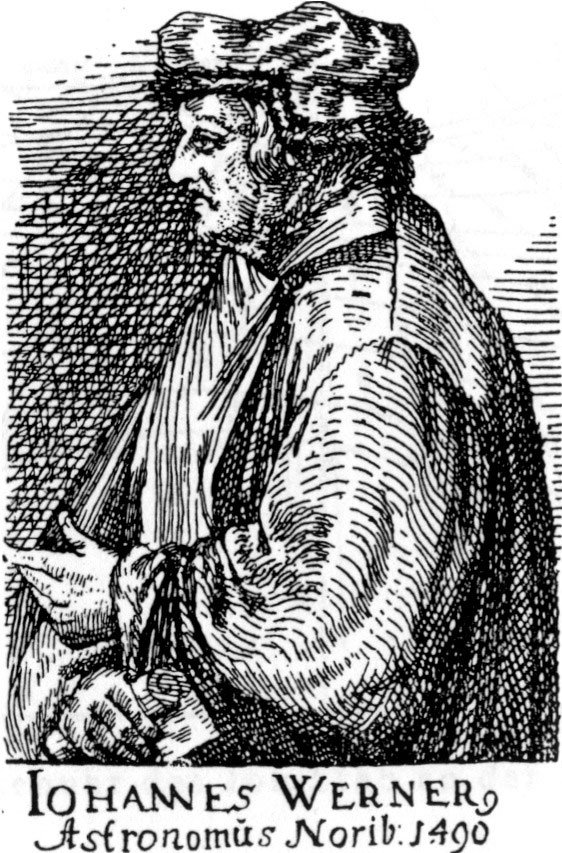
Next up we get a strange twist in the Dürer timeline from Strathern:
By the time Dürer returned home from his second visit to Italy, he was known by reputation throughout Europe. In 1512, the Holy Roman Emperor Maximilian I became one of his patrons. Despite this, Dürer found that he was making insufficient income from his paintings, and even abandoned this art form for several years in favour of making woodcuts and engravings – which could be reproduced and thus sold many times over. He may not have been the best painter in Europe, but his engravings were unsurpassed.
Dürer served his apprenticeship in the studio of Michael Wolgemut between 1486 and 1490. Wolgemut specialised in producing woodblock prints as book illustrations. For example, his studio produced the illustrations for the famous Liber Chronicarum, better known as the Nuremberg Chronicle in English and Die Schedel’sche Weltchronik in German. There are even speculations by art historians as to whether the young apprentice was responsible for some of those illustrations. From the very beginning when he set up his own workshop in 1495, Dürer specialised in woodblock printing. He also developed his skill in engraving, almost certainly learnt in his original apprenticeship under his father, a goldsmith. To illustrate a couple of quotes from Wikipedia:
Arguably his best works in the first years of the workshop were his woodcut prints, mostly religious, but including secular scenes such as The Men’s Bath House (ca. 1496). These were larger and more finely cut than the great majority of German woodcuts hitherto, and far more complex and balanced in composition.
His series of sixteen designs for the Apocalypse] is dated 1498, as is his engraving of St Michael Fighting the Dragon. He made the first seven scenes of the Great Passion in the same year, and a little later, a series of eleven on the Holy Family and saints. The Seven Sorrows Polyptych, commissioned by Frederick III of Saxony in 1496, was executed by Dürer and his assistants c. 1500. In 1502, Dürer’s father died. Around 1503–1505 Dürer produced the first 17 of a set illustrating the Life of the Virgin which he did not finish for some years. Neither these nor the Great Passion were published as sets until several years later, but prints were sold individually in considerable numbers.
In 1496 he executed the Prodigal Son, which the Italian Renaissance art historian Giorgio Vasari singled out for praise some decades later, noting its Germanic quality. He was soon producing some spectacular and original images, notably Nemesis (1502), The Sea Monster (1498), and Saint Eustace (c. 1501), with a highly detailed landscape background and animals.
Prints are highly portable and these works made Dürer famous throughout the main artistic centres of Europe within a very few years.
As you can see this is not post 1512 but we have just reached 1505 and Dürer is a highly prolific and famous producer of fine art prints. In fact, rather than being a painter, who turned to fine art printing for financial reasons, as Strathern would have us believe, Dürer was a highly successful fine art printer, who painted on the side.
We get the standard discussions of The Rhinoceros, Dürer’s most famous print, and Melancolia I, his most enigmatic and most interpreted print. I have only one question about Strathern’s waffle here, he writes about Melancolia I:
Though mathematics, especially geometry (Plato’s favourite), underlies much of the scene.
There is no other reference to Plato anywhere in his convoluted discussion of Melancolia I, so why shove him in here? Earlier he makes the equally strange comment:
Set into the wall above the angel’s head is a four-by-four magic square, indisputable evidence of Dürer’s continuing mathematical interest.
There was nothing to say that Dürer had ever stopped being interested in mathematics.
Having dealt with The Rhinoceros and before Melacolia I, Strathern enlightens us with the following paragraph:
As we have seen, the year 1500 marked one and a half millennia since the birth of Christ, and there was a widespread belief around this time that it heralded the Second Coming of Christ, which is mentioned in the Bible: ‘This same Jesus, which is taken up from you into heaven, shall so come in like manner as ye have seen him go into heaven.’ Such an event would precede the Last Judgement, after which our souls would be despatched to Purgatory, Hell or Heaven.
Various dates were considered by various people to signify the second coming but I personally have never come across a reference to 1500 as one of them.
Strathern also turns his spotlight on the Ehrenpforte Maximilians I, known in English as The Triumphal Arch or the Arch of Maximillian I, he writes:
Dürer created a number of works for his most important patron, Maximilian I. Amongst these is a large, highly complex woodcut of a triumphal arch, which measures almost ten feet by ten feet. Dürer spent over two years – on and off – busying himself with this work, which includes 195 separate woodcuts printed on 36 sheets of paper. The intention was that it should be hung in princely palaces and city halls throughout the Holy Roman Empire. Indeed, Maximilian I made a habit of giving away copies of this work with this intention.
The work itself is a suitably grandiose hotchpotch of styles – resembling, if anything, an example of Indian architecture rather than any classical triumphal arch (such as Marble Arch in London, or the Washington Square Arch in New York). It stands more as a monument to Dürer’s indefatigable technical expertise than any aesthetic achievement. Such a work made him rich, allowing him independence – even if it contributed nothing to his artistic attainment and was otherwise a complete waste of his time. [my emphasis]
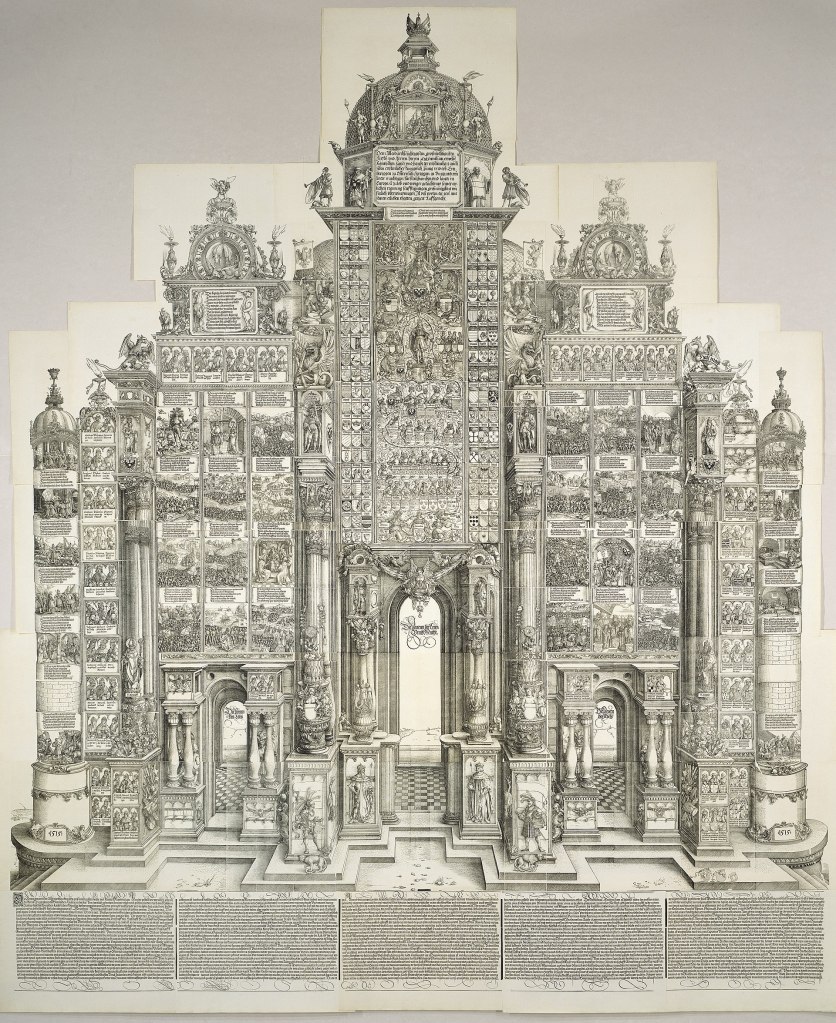
As is, unfortunately, all to common Strathern attributes this work to Dürer alone but it was the work of a group of people, quoting, yet again, Wikipedia:
The design program and explanations were devised by Johannes Stabius, the architectural design by the master builder and court-painter Jörg Kölderer and the woodcutting itself by Hieronymous Andreae, with Dürer as designer-in-chief. […] the flanking round towers are attributed to Albrecht Altdorfer.
The closing clause from Strathern, that I have emphasised, displays, in my opinion, his ignorance of the profession life of an artist and in particular that of his subject Albrecht Dürer. Dürer ran a highly professional, commercial fine art print studio, with which he not only earned the money on which he and his family lived but also the money with which he paid his employees. The Ehrenpforte was anything but a complete waste of time, as the commission raised the status of his studio and did in fact contribute to his artistic attainment, as it displayed his mastership in woodblock printing to the world.
Here we have the name of the mathematician, Johannes Stabius 1450–1522), who was the Imperial Court historian, was the director of the project, as he would employ Dürer on two further commissions, neither of which Strathern considers worth mentioning, despite his continued references to Dürer’s interest in mathematics.
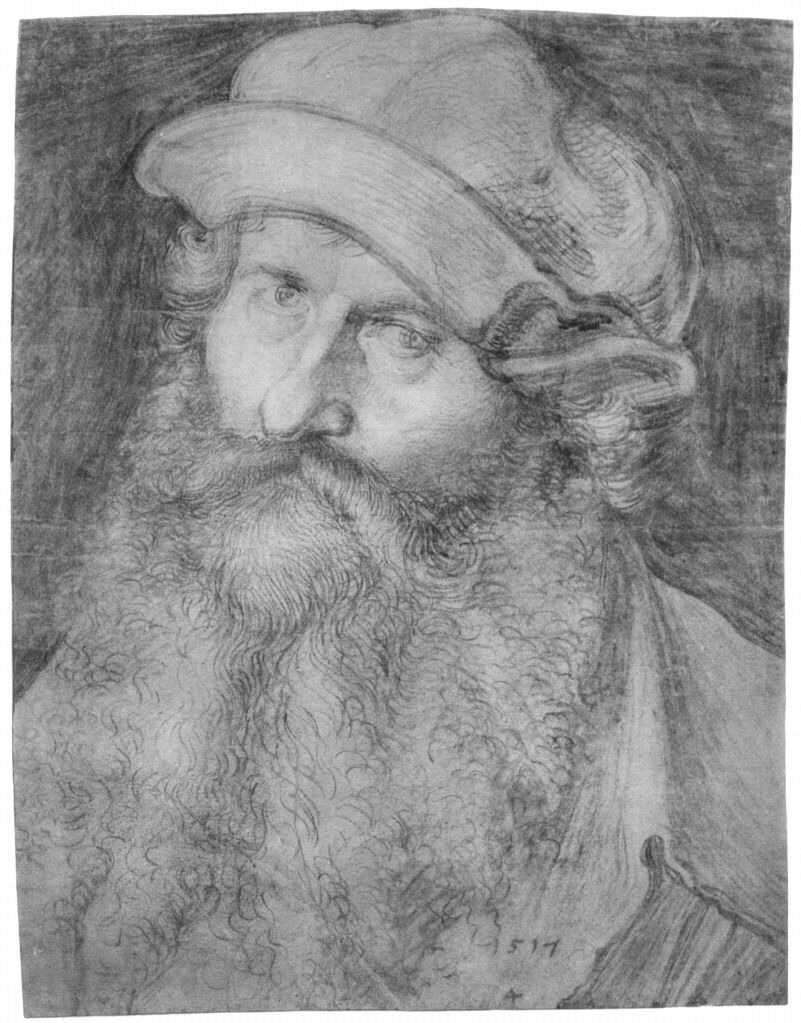
The first was the Stabius-Dürer World Map
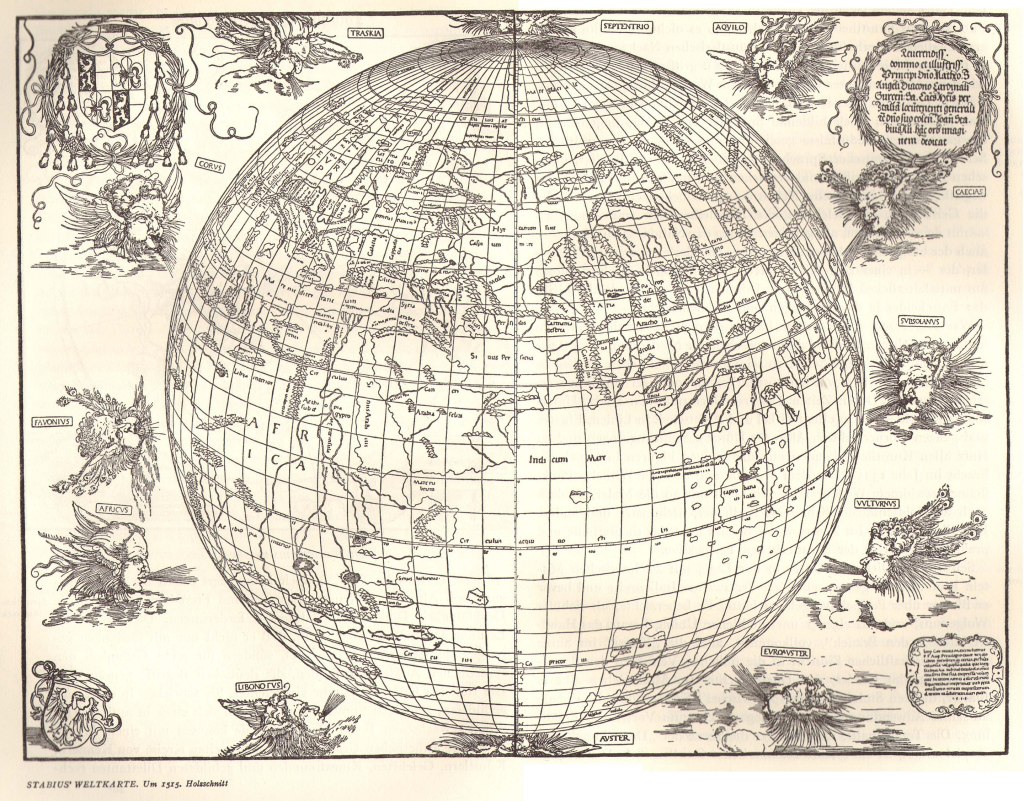
and the second, and historically much more important the Stabius-Dürer-Heinfogel planispheres of the southern and northern hemispheres, the first European, printed celestial maps, which I wrote about here.
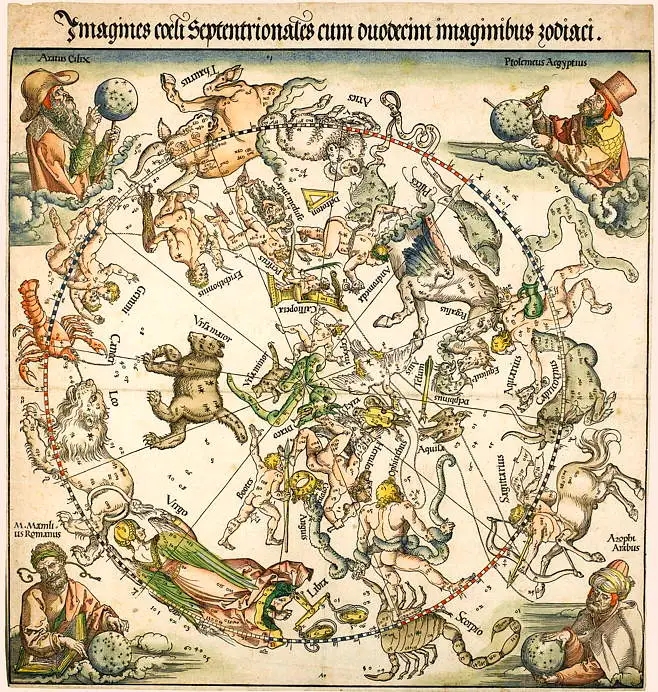
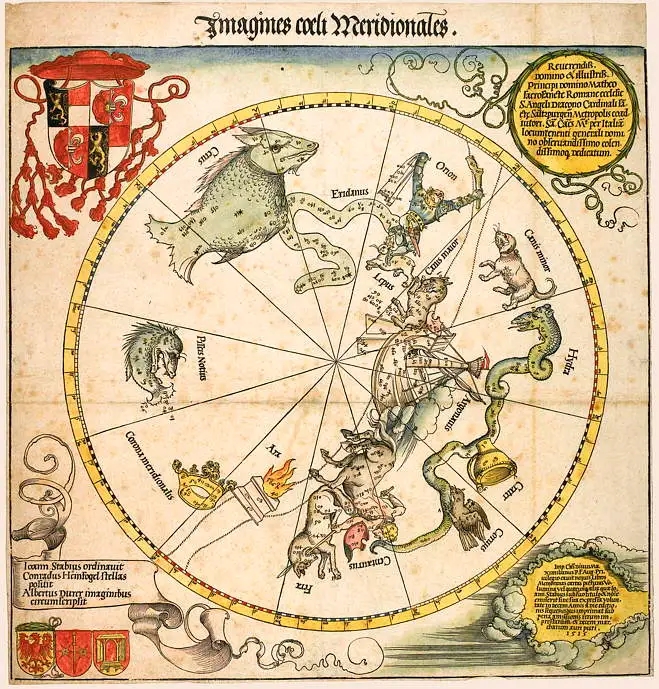
We get accounts of Dürer’s journey to the Netherlands to get his Imperial pension renewed following the death of Maximillian, including an account of his portrait of Erasmus and Strathern’s rather bizarre interpretation of its Greek inscription.
Almost at the end of his chapter, Strathern turns to Dürer the mathematician:
With Dürer’s eyesight fading, he devoted less of his energies to his art. Instead he concentrated on writing treatises on such subjects as ‘human proportions’ and ‘fortifications’. However, his most important work was his Four Books on Measurement. These contain the wealth of mathematical knowledge he accumulated during his life – including the geometrical construction of shadows in prints (projective geometry), as well as several ideas by the Tuscan artist Piero della Francesca which had not yet been published. (These Dürer had almost certainly learned from Luca Pacioli.) Very little of this vast compendium of work is original, but it was written in the vernacular German rather than in Latin. This established Dürer as the first figure of the northern Renaissance to outline in German Euclidean geometry and demonstrate the construction of the five Platonic solids, other Archimedean semi-regular truncated solids, and a number of constructed figures which are thought to have been of his own invention. His treatises were the first printed north of the Alps to view art in a scientific fashion, exposing the mathematical bones upon which much artistic flesh is based.
I’m sure Dürer would be delighted to know that his Four Books on Measurement was his most important work, whereas his ‘human proportions’ was just a treatise on “such subjects”!
About the time of his “second” journey to Italy, Dürer became obsessed with the idea that the secret of beauty lies in the mathematical theory of proportions. He began working on his Vier Bücher von menschlicher Proportion (Four Books on Human Proportion) in 1512 and the four books, written at different time over the years, deal with various aspects of exactly that, human proportion. An appendix to the book explains Dürer’s theories on ideal beauty.
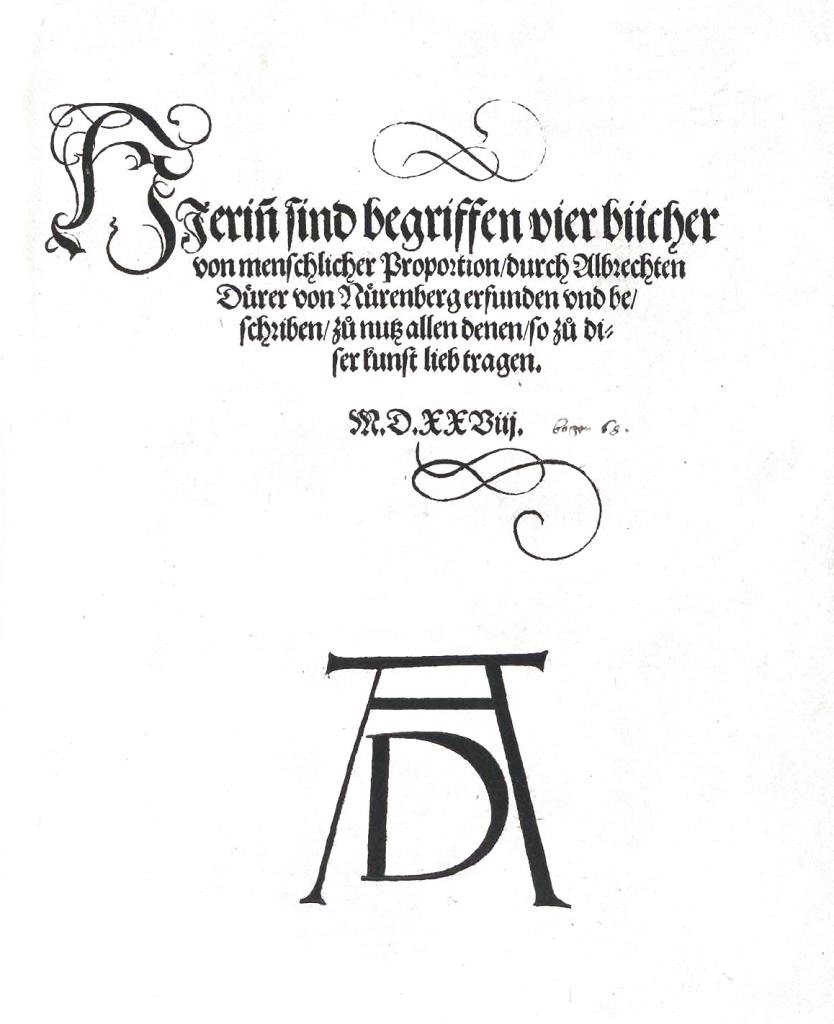
The book was written for apprentice artists and in the middle of the 1520s, Dürer realised that the geometry of the book was too advanced for the intended readers, so he sat down and wrote his Four Books on Measurement (Underweysung der Messung mit dem Zirckel und Richtscheyt or Instructions for Measuring with Compass and Ruler), (which I wrote about here) an introductory textbook on geometry for apprentice artists. It is the book on human proportions that is his most important work, the Four Books on Measurement merely developed the mathematical tools needed to understand it.
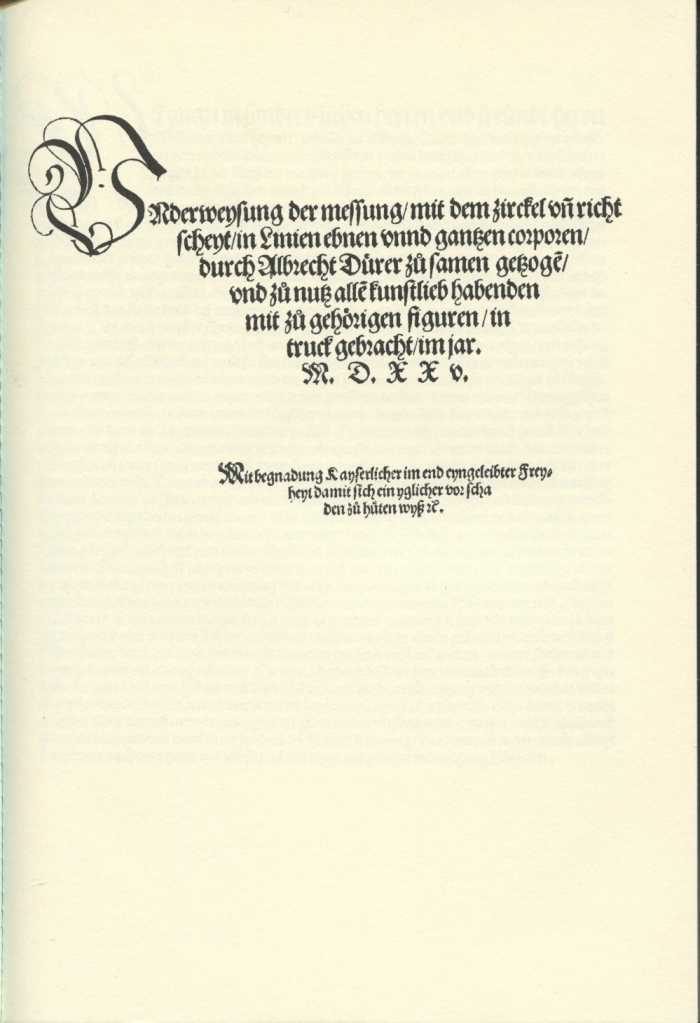
I have no idea which not yet published ideas from Piero della Francesca Dürer’s book supposedly contains. It goes without saying that Dürer didn’t learn anything from Luca Pacioli, whom he never met and with whom, as far as we know, he didn’t correspond. However, he might have accessed della Francesca work via Pacioli, who had plagiarised it in his Divina proportione, published in 1509, which was possibly owned by one of the Nürnberg mathematicians, Werner or Stabius, but that’s just speculation.
Far from being a vast compendium of work, Underweysung der Messung is 27cm X 18cm and probably less than 200 pages long, it’s not paginated so I had to guess. Dürer’s Underweysung der Messung is actually the very first mathematics book printed in German and like most textbooks it is of course derivative. However, it does contain one important geometrical innovation. Dürer introduced the geometry net, which is the two-dimensional figure that arises when you open a three-dimensional figure along edges.
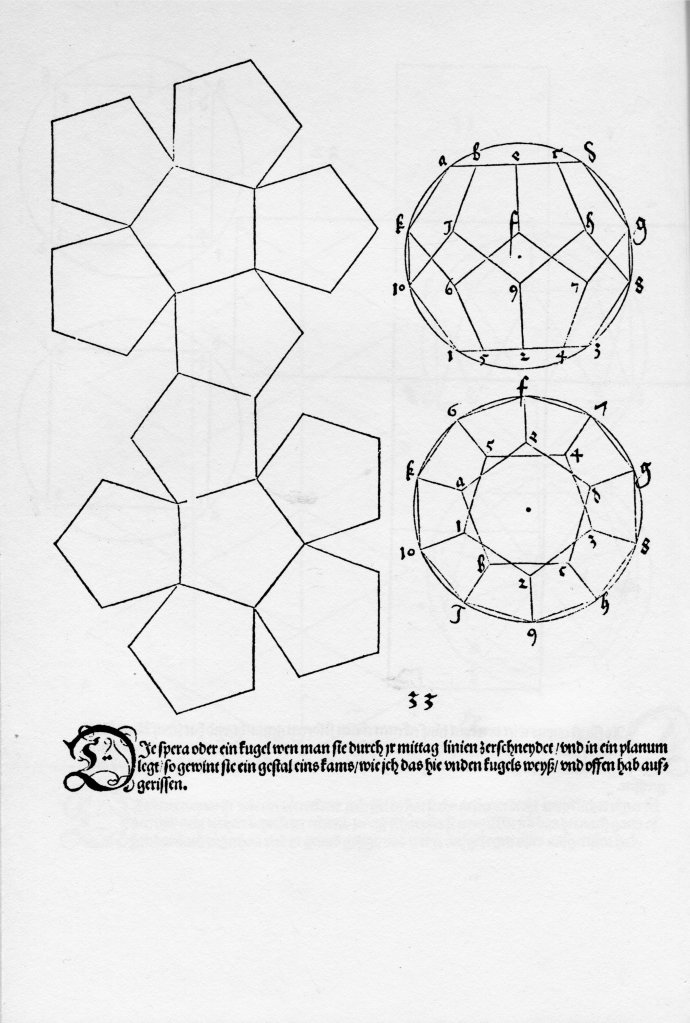
In one sense Underweysung der Messung did become more important than Vier Bücher von menschlicher Proportion both were into Latin and Underweysung der Messung was translated into several different European languages. Vier Bücher von menschlicher Proportion appealed to a very limited readership but Underweysung der Messung became a very widely read geometry textbook throughout Europe for most of the next hundred years.
Strathern has obviously not bothered to do serious research for his book but has just thrown it together from the first sources that crossed his path without bothering to check whether they were factually correct or not. As we will see in later chapters this sloppy approach is not confined to Dürer but is characteristic of the whole book.
[1] Susan Foister and Peter van den Brink eds., Dürer’s Journeys: Travels of a Renaissance Artist, National Gallery, London, distributed by Yale University Press, 2021.